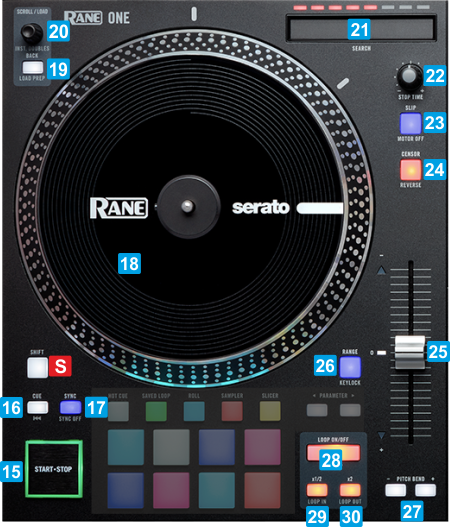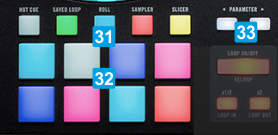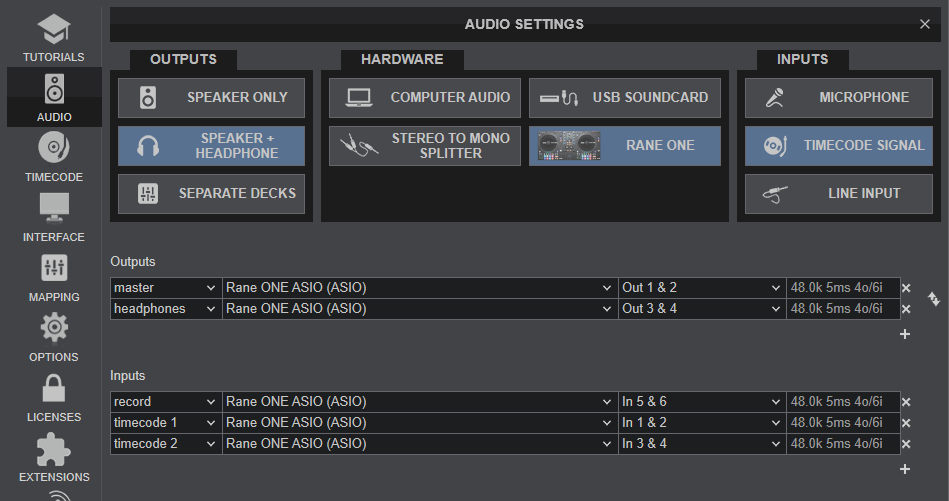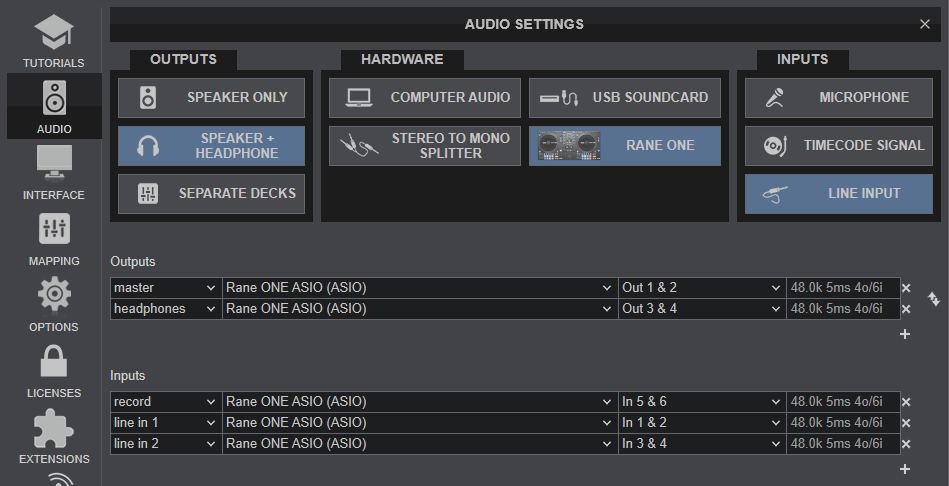RANE ONE

SETUP
Firmware & Drivers
Firmware: There is no firmware update available at the time this manual was written, but it's a good practice to check for updates at Rane DJ Downloads
Drivers: For both Windows and MacOS X computers Install the latest drivers (Control Panel) from Rane Dj Downloads
VirtualDJ Setup
Once VirtualDJ is launched, a Connect Window will appear. Please login with your preferred method from the ones provided.
A Pro Infinity or a Pro Subscription License is required to fully use the Rane One.
Without any of the above Licenses, the controller will operate for 10 minutes each time you restart VirtualDJ.
Buy a license

Click on the "One" button in order VirtualDJ to apply the pre-defined audio configuration for your device.
Make sure you have the top-panel Source selectors to USB-A or USB-B depending on the USB port you connected at the rear panel.
Click to OK.

MAPPING
The unit should be visible in the MAPPINGS tab of Config and the “factory default” available/selected from the Mappings drop-down list. The factory default Mapping offers the functions described in this Manual, however those can be adjusted to your needs via VDJ Script actions.
Find more details at VDJ Pedia

AUDIO Setup
The unit has a pre-defined Audio setup and a special button in the AUDIO tab of Config to provide that. Alternative Audio setups can be applied in the same window. See Advanced Setup for more details.

For further software settings please refer to the Manuals of VirtualDJ
LAYOUT

The functionality of each button, knob and slider per section (as shown in the image above) will be explained in detail in the next chapters
S SHIFT Hold this button down to access secondary functions of Rane Seventy as described in this manual
A MIXER & EFFECTS
B DECKS
C PADS
D REAR
E FRONT
MIXER & EFFECTS

KEY
ACTION
Push to set Beats Effect Parameter to 1 beat
Stems Equalizer modes are fully offered See Modern Equalizer
Set to LINE to route the audio signal of the Auxiliary LINE inputs(connections at the rear panel) to Left/right mixer Channels.VirtualDJ Decks will be muted in this case.
See further details in Advanced Setup
Deck Controls

KEY
ACTION
SHIFT (SECONDARY) ACTION
Push to load the selected track to Left/Right Deck
Push to load and clone the Track from the opposite Deck
PERFORMANCE PADS

KEY
ACTION
SHIFT (SECONDARY) ACTION
The pre-defined primary modes are ..
Hotcues, Saved Loop, Loop Roll, Sampler and Slicer
The pre-defined secondary modes are ..
Keycue, Beatjump, Loop, ScratchBank and Stems
The pre-defined modes/pages can be changed to your needs. Please see How to assign Pad modes
REAR PANEL

NAME
CONNECTION
Use these inputs to connect Timecode devices (for DVS). In this case, the top SOURCE switchers need to be at USB position.
Attention: When you connect a device on the PH/CD RCA plugs make sure that you also switch the PH/CD switch on the appropriate position depending on the device you have connected. Failing to do so may result in heavy distortion or a very weak signal of the analog source.
You can connect up to two computers by using the two ports of the device (labeled USB A and USB B).
Make sure that you turn the channel CH SOURCE SWITCHES at the top panel to the correct USB port for software mixing.
Please make sure that you have made all the necessary connections on the back of the unit before turning it's power ON.
FRONT PANEL


CONTROL
OPERATION
ADVANCED SETUP
MICROPHONES
The Rane One offers 2 Microphone inputs (connections at the rear panel) and various controls at the front panel for both of them. Both Microphone inputs are not part of the USB Audio Interface, and cannot be included in VirtualDJ Audio setup. None of the Mic controls of the device will control mic-related VDJ actions or GUI buttons and vice-versa.
Even though all Mic controls of Rane One send Midi messages and could be assigned to any VDJ script action, it is strongly advised not to do so, as the hardware operation will still apply.
Timecode (DVS)
VirtualDJ is offering DVS (Digital Vinyl System) support for the Rane One. A Timecode Plus or Pro Infinity license is required. 2 Timecode Inputs are available to control any software decks via Timecode CDs or Vinyls.
Both Mixer Channels can accept LINE (Timecode CDs) or PHONO Sources (Timecode Vinyls) depending on the CD/PH switchers at the rear panel of the unit.
- Connect your Timecode devices at the rear panel of the Rane One
- Open VirtualDJ configuration window and select the AUDIO tab on the left
- Click on the "TIMECODE SIGNAL" button to enable the timecode inputs
- Your sound setup should be like the one shown on the following image:

Rane One Audio Configuration with Timecode Inputs Configured - Click on "Apply" button
- Click on the TIMECODE icon on the left side of configuration window.
- Press PLAY on your timecode CD or Vinyl device and VirtualDJ will automatically detect your Timecode type and make the appropriate adjustments for best performance.
- Click on the ON buttons from the TIMECODE panels of the Default Skin to enable the Timecode control to any Deck.
- Press PLAY on your timecode CD or Vinyl device and VirtualDJ will automatically detect your Timecode type and make the appropriate adjustments for best performance.
- Press the CALIBRATE button if for any reason the signal is not detected (possibly due to reversed phase connections).
Live Inputs
The same Inputs as the one used for Timecodes, can be used as Live Inputs and route their audio signal to a VirtualDJ Deck (to apply Effects etc).
- Connect your Media devices at the rear panel of the Rane One to DECK 1/2 INPUTS sockets
- Open VirtualDJ configuration window and select the AUDIO tab on the left
- Click on the "LIVE INPUT" button to enable the Live inputs
- Your sound setup should be like the one shown on the following image:

Rane One Audio Configuration with Live Inputs - Click on "Apply" button
- Click on the ON buttons from the LINE IN panels of the Default Skin to enable the Live Inputs to any Deck.
Back to back
The Rane One has two USB ports, allowing simultaneous connection of two computers. Each port is completely independent. It is possible to run VirtualDJ on one computer and any other DJ-software on the other, Mac or PC.
How to:
- Connect the 2nd computer to the unused USB port on the device.
- Set the Source switcher of the non-playing mixer channel to the USB source of the 2nd computer.
- Play a track on this deck and mix it when ready – you ll' now have audio from both computers during the mix.
- Fade out the audio playing from the 1st computer to the audio playing from the 2nd one.
- When only audio from the 2nd computer is left in the mix, remove the first computer.
- Assign the Input Source for the remaining free mixer channel to the 2nd computer and keep mixing.
Recording
The Rane One has a dedicated Input to record your Main Mix. VirtualDJ has pre-configured this input for recording, thus no special setting is required in order to record your mix (including analogue sources and Microphone).
Use the REC or BSCAST buttons from the MASTER center panel of the VirtualDJ GUI to Record or Broadcast your mix.
